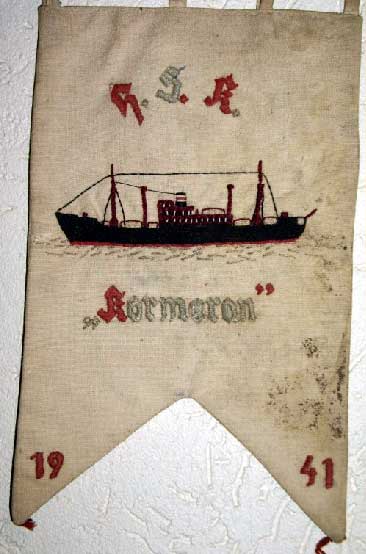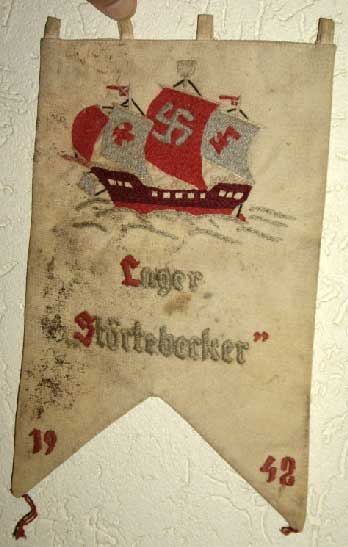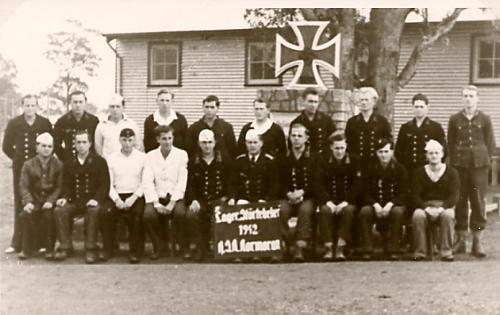|
Letters
Kormoron (Kormoran) flag made by POW Hi, my name is Irene Dargan, my Grandfather looked after POWs at Murchison Camp Victoria in 1942 and was given a flag embroided by the Kormoron navy seaman. It has a picture of the Kormoron on one side with its name and on the other side another ship with Nazi swatstikas on the flags. He embroided the name I wondered if you know anyone who would be interested in the artefact, Thankyou
What an interesting story, I suggest you take a photograph of this treasure, and put it up on eBay with a price on it that would satisfy you, and see what results you get. I would be suprised if there was not a deal of interest shown. I would love to have a copy of any photograph, so we might add it to AHOY at our Kormoran article. Thank you for getting in touch. Regards,
P.S. It is noted that the spelling of the German Raider's name used by this POW flag maker is Kormoron. In most instances, and on the German site about Armed Raiders the spelling is Kormoran, which is our choice in all references otherwise used on AHOY. Thanks,
Thanks for your fast response, I have sent the two halves of the flag to Terry, my webmaster and friend in Atlanta Georgia to put up on AHOY, and will mail you when its there. One just never knows what will come your way via the net, I am continually suprised, and in your case delighted. Again, I must reiterate my gratitude to you for getting in touch and then generously responding to my request to share your flag with us. I have sent the details off to an American freelance journalist Ward who lives in Germany, and has some contact with ex Kormoran sailors. Should I get a positive reaction from him, I will naturally pass it on to you. Best regards, and good luck with your disposal. Mac.
Thought you may like some more information I have acquired since we last emailed...I have now found out more about it and wondered if your friends would be interested in it as well. The Beer Company not realizing they were also a part of Australian History regarding the Kormoran and the POWs from it. Thankyou for your time.
I have sent you pictures of the flag and the embroidery and the Lager Stortebecker POWs and the picture they took. Thankyou
Thanks for that. Might we please have a copy of the photograph of Kormoran survivors? Who is Randy, and is he from the German Brewery? Also who is Jane Peek, and again where is she from please? Sorry to be so nosey, but it will fill out this quite amazing story both for me at a personal level, and our AHOY readers in general. Best regards. Hi, The woman Jane Peek is from this info ISS Information
she was able to shed some light on the event. Regards
My name is Thomas Koulis and I am now 19 years old. I live in a small village called Partington, which is in the North West of England, near Manchester. I have recently seen the article about this flag. I would be very interested in getting in touch with Mrs. Irene Dargan about the flag. Could you please tell her of my interest for me? I have had a long interest in the German Kriegsmarine of WW2 and have been fortunate to have been able to contact a number of Veterans from the service. Your help would be much appreciated! With best wishes from England! Thomas. Flag of the commerce raider Kormoran
you mention on the following pages Klaus Störtebeker (or Störtebecker, as he is spelled nowadays - his name means to drink one beer mug dry in one swallow - Stürz den Becher) was the most famous german pirate to have ever lived. He was born somewhere around 1360 and beheaded in Hamburg in the year 1401. He was the leader of the likedeelers, a group of pirates who were famous for dividing the plunder equally among themselves. (Likedeeler means "Equally divider" in old Störtebeker and his compatriots used the war between Margerete of Denmark and Albrecht of Sweden to obtain letters of marque and preyed on ships of the Deutsche Hanse, even managing to rule over the city of visby until the Over the years Störtebeker became a folk hero, and tales of his exploits, bravery and superior seamanship are popular in northern germany even today. (The most famous being that he managed to free seven of his men by running past them after being beheaded). Each year, there is a Störtebeker festival on the Island of Rügen. It is in my opinion quite easy to assume that commerce raiders such as the crew of the Kormoran would be acquainted with the legend of Störtebeker, especially if they were recruited from northern Germany. Störtebeker with few and outclassed ships managed to evade the might of the Hanse for over a decade and gained the reputation of a folk hero, while the crew of the Kormoran tried to evade the mighty RN and prey on enemy shipping, so one could see why he would appeal to them. Furthermore, while the ship depicted looks more like a Caravel than a Cog, there are enough similarities (the high forecastle and upper works) to indicate the artist meant a Hansekogge, the type of ship Störtebeker used. In closing, allow me a small observation - in old german, the letters "a" and "o" look quite alike, and it would be easy to mistake them for another. There is no reason to speculate that the crew member - if the POW made flag
Thank you for your very interesting comments. You have given a whole new perspective to this flag that I believe was stitched whilst the Kormoran crew were in captivity in a POW camp in my State of Victoria in WW2. We will add your remarks to the piece on AHOY about this flag. Best wishes from Australia.
|



